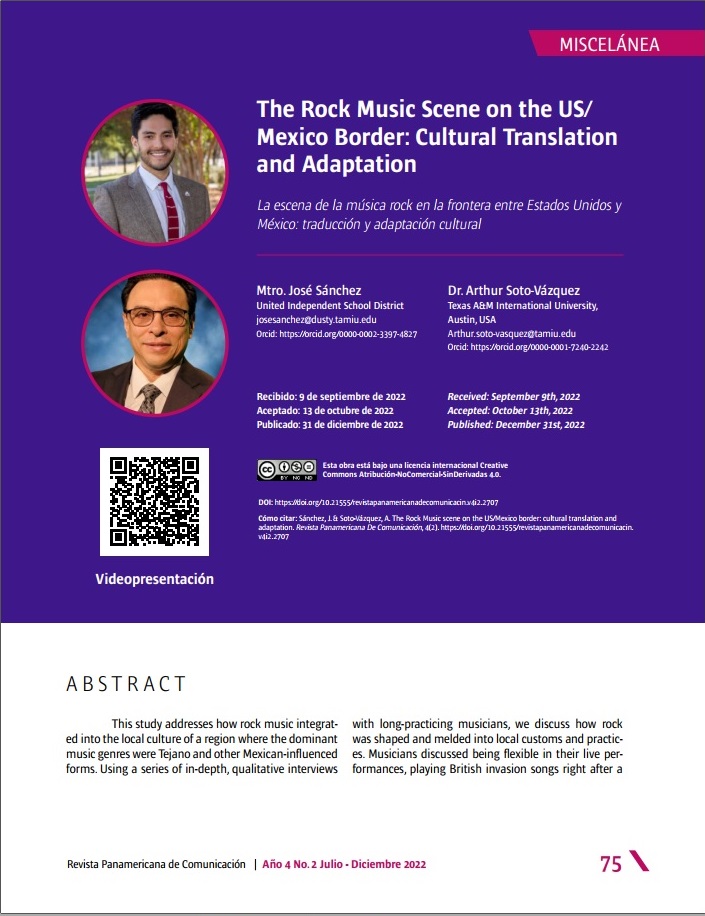La escena de la música rock en la frontera entre Estados Unidos y México: traducción y adaptación cultural
Contenido principal del artículo
Resumen
Este estudio aborda cómo la música rock se integró en la cultura local de una región donde los géneros musicales dominantes eran el tejano y otras formas de influencia mexicana. Usando una serie de entrevistas cualitativas y profundas con músicos de larga práctica, discutimos cómo se formó el rock y cómo se mezcló con las costumbres y prácticas locales. Los músicos hablaron sobre ser flexibles en sus presentaciones en vivo, tocar canciones de la invasión británica justo después de un corrido, ser marginados y actuar en ranchos fuera de los límites de la ciudad cuando los clubes no los presentaban. Sin embargo, la escena de la música rock local se desarrolló en el sur de Texas y se convirtió en un híbrido cultural único. Usamos este ejemplo para discutir cómo se ve la hibridez cultural en el contexto de la interpretación musical, el papel de los nuevos medios en su avance y lo que significa para la identidad fronteriza.
Detalles del artículo
Sección

Esta obra está bajo una licencia internacional Creative Commons Atribución-NoComercial-SinDerivadas 4.0.
Cómo citar
Referencias
» Anzaldúa, G. (1987). Borderlands/la frontera: The new mestiza. San Francisco, CA, Aunt Lute Books.
» Avant-Mier, R. (2010). Rock the nation: Latin/o identities and the Latin rock diaspora. New York, NY Bloomsbury Publishing.
» Bennett, A., & Peterson, R. A. (2004). Music scenes: Local, translocal and virtual. Nashville, TN, Vanderbilt University Press.
» Beer, D. (2006). The Pop-Pickers have picked decentralised media: The fall of Top of the Pops and the rise of the second media age. Sociological Research Online, 11(3), 26–33. En https://doi.org/10.5153/sro.1429
» Brae, C. (2018). New channels of music distribution: A complete guide to music distribution, music business, promotions, and selling music. New York, NY, Routledge.
» Braun, V., & Clarke, V. (2006). Using thematic analysis in psychology. Qualitative Research in Psychology, 3(2), 77–101. En https://doi.org/10.1191/1478088706qp063oa
» Díaz-Santana Garza, L. (2021). Between Norteño and Tejano Conjunto: Music, Tradition, and Culture at the US-Mexico Border. Lanham, MD, Rowman & Littlefeld.
» Camarota, S. A. (2011, October 5). A record-setting decade of immigration: 2000-2010. CIS.org. En https://cis.org/Report/RecordSetting-Decade-Immigration-20002010
» Editors of Encyclopædia Britannica. (2021, August 31).Tejano. Retrieved October 22, 2021, from https://www.britannica.com/art/Tejano-music
» Heine, C. M. (2012). Scene and unscene: Revealing the value of the local music scene in Savannah, Georgia. Ethnographic Praxis in Industry Conference Proceedings, 2012(1), 200–216. En https://doi.org/10.1111/j.1559-8918.2012.00022.x
» Kelly, K. (2015, July 3). Revisiting America’s satanic panic: When heavy metal and the devil himself stalked the Earth. VICE. En https://www.vice.com/en/article/r3za83/satanic-panic-interviews
» Kruse, H. (2010). Local identity and independent music scenes, online and off. Popular Music and Society, 33(5), 625–639.En https://doi.org/10.1080/03007760903302145
» Leyshon, A. (2009). The software slump?: Digital music, the democratisation of technology, and the decline of the recording studio sector within the musical economy. Environment and Planning A: Economy and Space, 41(6), 1309–1331.En https://doi.org/10.1068/a40352
» Lindlof, T. R., & Taylor, B. C. (2019). Qualitative communication research methods. London, SAGE Publishing.
» Lozano, J. C. (2017). Film at the border: Memories of cinemagoing in Laredo, Texas. Memory Studies, 10(1), 35–48. En https://doi.org/10.1177/1750698016670787
» Ragland, C. (2009). Música Norteña: Mexican Americans creating a nation between nations. Philadelphia, PA Temple University Press.
» Said, E. (1990). Figures, confgurations, transfgurations.Race & Class, 32(1), 1–16. En https://doi.org/10.1177/030639689003200101
» Sanchez, J. (2022, May 5). Between a rock and a hard place: Rock on the border between nations and cultures (Thesis, Texas A&M
International University). Research Information Online. En https://rio.tamiu.edu/etds/185
» Straw, W. (1991). Systems of articulation, logics of change: Communities and scenes in popular music. Cultural Studies, 5(3),
–388. En https://doi.org/10.1080/09502389100490311
» Sturges, J. E., & Hanrahan, K. J. (2004). Comparing telephone and face-to-face qualitative interviewing: A research
note. Qualitative Research, 4(1), 107–118. En https://doi.org/10.1177/1468794104041110
» Tejeda, J. (2014). Tejano: Local music, global identity. Grantmakers in the Arts. En https://www.giarts.org/article/tejano-local-music-global-identity
» Texas State Historical Association. (n.d.). Texas Almanac: City population history from 1850–2000. En http://texasalmanac.com/sites/default/fles/images/CityPopHist%20web.pdf
» U.S. Census Bureau (2021). American Community Survey, Laredo, TX. En https://data.census.gov/cedsci/table?q=Laredo%20city,%20Texas&tid=ACSST1Y2021.S0601
» Verboord, M., & van Noord, S. (2016). The online place of popular music: Exploring the impact of geography and social media on pop artists’ mainstream media attention. Popular Communication, 14(2), 59–72. En https://doi.org/10.1080/15405702.2015.1019073
» Vila, P. (2003). Processes of identifcation on the US-Mexico border. The Social Science Journal, 40(4), 607–625. En https://doi.org/10.1016/S0362-3319(03)00072-7
» Williams, S. (2017a, February 20).Rock ‘n’ roll and “moral panics” – Part one: 1950s and 1960s. Evansville, IN, University of Southern Indiana University Communications. En https://www.usi.edu/news/releases/2017/02/rock-n-roll-and-moral-panics-partone-1950s-and-1960s/
» Williams, S. (2017b, February 27). Rock n roll and “moral panics” – Part two: 1970s – 1990s. Evansville, IN, University of Southern Indiana University Communications. En https://www.usi.edu/news/releases/2017/02/rock-n-roll-and-moral-panics-part-two-1970s-1990s/
» World Population Review. (2021). Laredo, Texas population 2021. En https://worldpopulationreview.com/us-cities/laredo-tx-population

